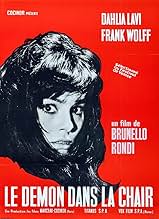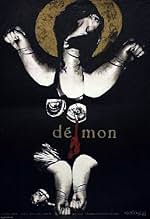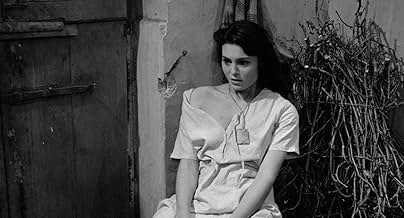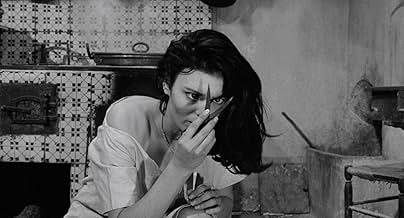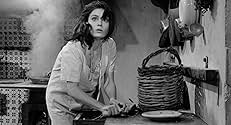CALIFICACIÓN DE IMDb
7.2/10
1.5 k
TU CALIFICACIÓN
Una joven campesina solitaria y sexualmente desinhibida es sometida a un exorcismo después de maldecir a un hombre que rechaza sus insinuaciones.Una joven campesina solitaria y sexualmente desinhibida es sometida a un exorcismo después de maldecir a un hombre que rechaza sus insinuaciones.Una joven campesina solitaria y sexualmente desinhibida es sometida a un exorcismo después de maldecir a un hombre que rechaza sus insinuaciones.
- Dirección
- Guionistas
- Elenco
- Premios
- 1 premio ganado y 1 nominación en total
Anna María Aveta
- Sister Angela
- (as Anna Maria Aveta)
María Teresa Orsini
- Nun
- (as Maria Teresa Orsini)
Luciana Angiolillo
- La Signora di Craco
- (sin créditos)
Andrea Bosic
- Priest
- (sin créditos)
Nino Castelnuovo
- Buca
- (sin créditos)
Giovanni Cristofanelli
- Padre Tommaso
- (sin créditos)
Laura Nucci
- La Madre di Purif
- (sin créditos)
Nicola Tagliacozzo
- Zio Giuseppe
- (sin créditos)
Opiniones destacadas
Brunello Rondi's remarkable drama takes a very naturalistic approach to its tale of Witchcraft and Possession in Southern Italy. An attractive young woman, Puri (Daliah Lavi) seems to be in the throes of Amour Fou with a young man, Antonio (Frank Wolff). When he tells her he's getting married, Puri's rage turns into casting an evil spell on Antonio, his marriage and future offspring. Puri's rantings give way to bouts of apparent possession, speaking in tongues and contortions of her body*. She is condemned as a witch and presented to the local priest for exorcism.
Rondi, a long-time screenwriting collaborator with Federico Fellini (including two Oscar nominations) fashions his film as a folk horror tale in the vein of a WICKER MAN, KWAIDAN or THE WITCH. What is real and what isn't is far less important than an exploration of an unfortunate soul and the locals who cast her out. Rondi's script is replete with specific local Italian traditions and rituals which provide added layers into his examination of the intersection of superstition and religion and how they seemingly over-ride any compassion for the woman's mental health and stability. Cinematographer Carlo Bellero's stunning Black & White camerawork pits Puri against the forboding barren landscape capturing her feeling of isolation from her people and home. Piero Piccioni's score is quite good. None of this would truly work without a superb performance by Lavi (who is best known in the U. S. for the original CASINO ROYALE and TWO WEEKS IN ANOTHER TOWN). She brings an earthy intensity and her background in dance allowed her to perform her seemingly superhuman stunts.
IL DEMONIO is a dark but uniquely fascinating example of tragic folklore on film.
* This 'Spiderwalk' has drawn comparison the William Peter Blatty and William Friedkin's THE EXORCIST released a decade later.
Rondi, a long-time screenwriting collaborator with Federico Fellini (including two Oscar nominations) fashions his film as a folk horror tale in the vein of a WICKER MAN, KWAIDAN or THE WITCH. What is real and what isn't is far less important than an exploration of an unfortunate soul and the locals who cast her out. Rondi's script is replete with specific local Italian traditions and rituals which provide added layers into his examination of the intersection of superstition and religion and how they seemingly over-ride any compassion for the woman's mental health and stability. Cinematographer Carlo Bellero's stunning Black & White camerawork pits Puri against the forboding barren landscape capturing her feeling of isolation from her people and home. Piero Piccioni's score is quite good. None of this would truly work without a superb performance by Lavi (who is best known in the U. S. for the original CASINO ROYALE and TWO WEEKS IN ANOTHER TOWN). She brings an earthy intensity and her background in dance allowed her to perform her seemingly superhuman stunts.
IL DEMONIO is a dark but uniquely fascinating example of tragic folklore on film.
* This 'Spiderwalk' has drawn comparison the William Peter Blatty and William Friedkin's THE EXORCIST released a decade later.
With stark but glorious chiaroscuro and solid performances, Il Demonio is a creepy trip through a world of ritual, magic, and superstition. Ms. Lavi drives the film with her terror and passion. I felt like I was peeking into a world in which logic was replaced by myth. What an experience.
Until I posted this review, only 8 people had reviewed Il demonio and I feel like that's a real shame that it does not get the attention of some of Bava's or Fulci's films. In fact, I don't have hard proof of this but I believe Il Demonio was Fulci's inspiration (in part) for Don't Torture a Duckling.
Il demonio is a genuinely disturbing film and there is no way that it's not a classical inspiration to later films about witches and witchcraft. Like Fucli's later film, Brunello Rondi set his film somewhere in an undeveloped area of rural Southern Italiy where superstition and ignorance prevent women from expressing themselves sexually or at all as individuals, and even in the instance of mental illness or emotional disturbance, families abuse their sick relative and authoritarian religious figures abuse and take advantage of mentally unstable people, particularly sexually abusing women and young people.
Il demonio may even be landmark for its time, i am not enough of an "expert" about film to say for sure - because it challenges the Roman Catholic Church head-on in a way that craftier arthouse flicks or more satirical horror films about Satanists or hippies did not in the 1960s.
A bleak portrait of a woman abused by her father and sexually molested by religious figures and eventually other men does serve as a mirror for Don't Torture a Duckling nearly a decade later with its theme of religious abuse and a very specific character rejected as a witch by the entire town for having mental health issues or emotional disturbance after losing her infant child.
I just wish Il demonio had been in color. One of my gripes about Don't Torture a Duckling which keeps me from rating it a 10 as a giallo is Fulci's outright derision and snobbery towards Southern Italian peasants (Fulci was born in Rome) that is illustrated by how ridiculous most of the peasants are and how oppressive BROWN is throughout the film. Maybe that's how Fulci felt, maybe he was trying to communicate oppression by lack of color, but Southern Italian culture is generally the opposite - so colorful, bold and theatrical that I really do wonder what Il demonio would have looked like in color. I bet it would have won awards.
Il demonio is a genuinely disturbing film and there is no way that it's not a classical inspiration to later films about witches and witchcraft. Like Fucli's later film, Brunello Rondi set his film somewhere in an undeveloped area of rural Southern Italiy where superstition and ignorance prevent women from expressing themselves sexually or at all as individuals, and even in the instance of mental illness or emotional disturbance, families abuse their sick relative and authoritarian religious figures abuse and take advantage of mentally unstable people, particularly sexually abusing women and young people.
Il demonio may even be landmark for its time, i am not enough of an "expert" about film to say for sure - because it challenges the Roman Catholic Church head-on in a way that craftier arthouse flicks or more satirical horror films about Satanists or hippies did not in the 1960s.
A bleak portrait of a woman abused by her father and sexually molested by religious figures and eventually other men does serve as a mirror for Don't Torture a Duckling nearly a decade later with its theme of religious abuse and a very specific character rejected as a witch by the entire town for having mental health issues or emotional disturbance after losing her infant child.
I just wish Il demonio had been in color. One of my gripes about Don't Torture a Duckling which keeps me from rating it a 10 as a giallo is Fulci's outright derision and snobbery towards Southern Italian peasants (Fulci was born in Rome) that is illustrated by how ridiculous most of the peasants are and how oppressive BROWN is throughout the film. Maybe that's how Fulci felt, maybe he was trying to communicate oppression by lack of color, but Southern Italian culture is generally the opposite - so colorful, bold and theatrical that I really do wonder what Il demonio would have looked like in color. I bet it would have won awards.
"Il demonio" follows Puri, a young peasant woman in a small Italian villa who is obsessed with Antonio, a married man. Puri's sickly fixation on Antonio leads her to practice witchcraft in an attempt to direct him to her, but instead, she becomes subject of a witch-hunt when she becomes apparently possessed.
This obscure Italian shocker predates mainstream possession film such as "The Exorcist" (by ten years!), and, while it is not as gratuitous as that film or the others in its wake, "Il demonio" is no less a powerful, artful exploration of obsession, superstition, and evil. One of its most intriguing components is that it consistently toes the line between "is it real?" and fully committing to being outright supernatural--at times, it appears that perhaps Puri is being persecuted for her zany (though ostensibly harmless and ineffective) attempts at witchcraft--at others, however, the reality of the situation is not so clear.
In either case, the character of Puri is a tragic one, as her mental illness is either misunderstood, or, perhaps, leads her to fall prey to a demonic force. Daliah Lavi's performance as Puri glues the film together, as she is both tragic and pitiful--Lavi's acting never goes too far over the edge, but it comes tantalizingly close. The film is further bolstered by its gorgeous, expressionistic imagery, with stark black-and-white photography pinning the characters against vast landscapes, at times resembling something you might see in an Ingmar Bergman feature.
The screenplay does feel a tad clunky in its final act, but its resolution brings it full circle in a befitting (albeit downbeat) manner. All in all, "Il demonio" is a powerful film that consistently leaves the audience turning it over in their heads. Ambiguity is very well utilized, and Lavi's riveting lead performance is key--be it a case of the psychological or the spiritual, "Il demonio" is potent no matter how you read it. 9/10.
This obscure Italian shocker predates mainstream possession film such as "The Exorcist" (by ten years!), and, while it is not as gratuitous as that film or the others in its wake, "Il demonio" is no less a powerful, artful exploration of obsession, superstition, and evil. One of its most intriguing components is that it consistently toes the line between "is it real?" and fully committing to being outright supernatural--at times, it appears that perhaps Puri is being persecuted for her zany (though ostensibly harmless and ineffective) attempts at witchcraft--at others, however, the reality of the situation is not so clear.
In either case, the character of Puri is a tragic one, as her mental illness is either misunderstood, or, perhaps, leads her to fall prey to a demonic force. Daliah Lavi's performance as Puri glues the film together, as she is both tragic and pitiful--Lavi's acting never goes too far over the edge, but it comes tantalizingly close. The film is further bolstered by its gorgeous, expressionistic imagery, with stark black-and-white photography pinning the characters against vast landscapes, at times resembling something you might see in an Ingmar Bergman feature.
The screenplay does feel a tad clunky in its final act, but its resolution brings it full circle in a befitting (albeit downbeat) manner. All in all, "Il demonio" is a powerful film that consistently leaves the audience turning it over in their heads. Ambiguity is very well utilized, and Lavi's riveting lead performance is key--be it a case of the psychological or the spiritual, "Il demonio" is potent no matter how you read it. 9/10.
A tough and, at times, heartbreaking film about a witch who places a spell on the man she loves so he'll break up with his wife and be with her and all the horror and drama it causes her and the entire town. Filmed in stark black and white, The Demon still packs a punch and showcases a very different kind of horror - the horror of humanity, group think, and mob mentality.
¿Sabías que…?
- TriviaDaliah Lavi cited this as her favorite movie and her best performance.
- ConexionesFeatured in Folk Horror: Bosques sombríos y días de embrujo (2021)
Selecciones populares
Inicia sesión para calificar y agrega a la lista de videos para obtener recomendaciones personalizadas
- How long is Il demonio?Con tecnología de Alexa
Detalles
- Tiempo de ejecución1 hora 38 minutos
- Color
- Mezcla de sonido
- Relación de aspecto
- 1.66 : 1
Contribuir a esta página
Sugiere una edición o agrega el contenido que falta

Principales brechas de datos
By what name was El demonio (1963) officially released in India in English?
Responda
